This reprint by the Gettysburg Discussion Group is done with the permission of the author. The book is available for purchase at the Gettysburg National Battlefield Bookstore.
![]()
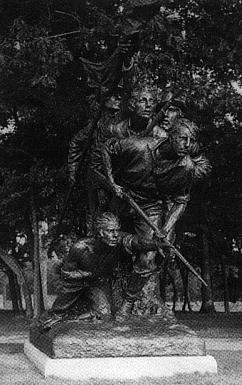
To compensate for the lack of southern regimental markers on the field, over the last seventy years the various southern states have placed large memorials along the Seminary Ridge battle line. One of the earliest of these was the North Carolina Memorial built to honor twenty-three regiments, three cavalry regiments, three artillery batteries and one infantry battalion that participated in the battle. The statue was sculpted by Gutzon Borglum whose works include the carving on Mt. Rushmore. Among the most artistic monuments on the field, it was designed to commemorate the valor, bravery, and courage of the men from North Carolina.1
Located approximately where Pettigrew's North Carolina brigade of Heth's division emerged into the open fields during Pickett's Charge, Borglum wanted to depict a group of infantry men who had "...just been ordered to charge across that very bloody field."2 One figure represents a wounded officer who is urging his men on, pointing out to the enemy to the front. To his rear, a veteran whispers words of encouragement to a younger comrade while behind the group, the color bearer brings up the flag.3 All of the faces of the men were modeled using photographs of actual Confederate veterans. The model for the color bearer was Orren Randolph Smith of Henderson, North Carolina, the man who had designed the Confederate National flag, The "Stars and Bars."4
Near the main statue is a monolith containing the names of the North Carolina units that were a part of the Army of Northern Virginia. It was built under the auspices of the United daughters of the Confederacy and was dedicated the same day as the main statue.
LOCATION: WEST CONFEDERATE AVENUE
DEDICATED: JULY 3, 1929
COST: $50,000
SCULPTOR: GUTZON BORGLUM
CONTRACTOR: A. KUNST FOUNDRY
MATERIAL: STANDARD BRONZE
SPECIFICATIONS: HT-15' 9"
Base - 6'6"W X 9'9"L
1 Wayne Craven. Sculptures at Gettysburg, (Eastern Acorn Press, 1982.) p. 86
2 William C. Davis, Gettysburg: The Story Behind the Scenery, (Las Vegas: K. C. Publications, Inc., 1983), p. 37; Craven, Sculptures, p. 86
3 Herbert L. Grimm and Paul Roy, Human Interest Stories of the Three Days of the Battle of Gettysburg with Pictures(Gettysburg: Times and News Publishing Company, 1969), p. 50
4 Craven, Sculptures
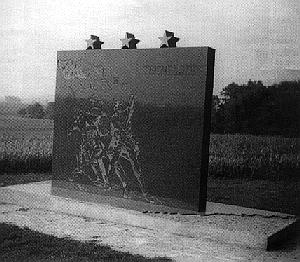 The units honored by the memorial were part of Archer's brigade of General Heth's division. The unit that opened the battle for the Confederates on July 1. The first Confederate casualty of the battle, Private Henry C. Rison was a member of Company B, 7th Tennessee Infantry. He suffered a gunshot wound that fractured his thigh while on skirmish duty early on July 1. On August 15, Private Rison died in a Union hospital . At 3 P.M. on July 3, the survivors of three Tennessee regiments would participate in the last infantry action of the battle as they advanced from the area near this site to assault the Union lines during "Pickett's Charge." It can therefore be said that Tennessee troops both opened and closed one of the great battles in history.
The units honored by the memorial were part of Archer's brigade of General Heth's division. The unit that opened the battle for the Confederates on July 1. The first Confederate casualty of the battle, Private Henry C. Rison was a member of Company B, 7th Tennessee Infantry. He suffered a gunshot wound that fractured his thigh while on skirmish duty early on July 1. On August 15, Private Rison died in a Union hospital . At 3 P.M. on July 3, the survivors of three Tennessee regiments would participate in the last infantry action of the battle as they advanced from the area near this site to assault the Union lines during "Pickett's Charge." It can therefore be said that Tennessee troops both opened and closed one of the great battles in history.
1 David G. Martin, Confederate Monuments at Gettysburg, (Highstown, N. J. : Longstreet House, 1986), pp. 50-51
LOCATION: WEST CONFEDERATE AVENUE
DEDICATED: JULY 2, 1982
COST: $25,000
MATERIAL: CARNELLIAN SELECT GRANITE
ELBERTON GRAY MARBLE
SPECIFICATIONS: 8'10"L X 6'H X 10"W
Placed on the site from which Lee observed portions of the battle, the equestrian statue of the General ranks among the finest anywhere in the world. To capture the features, Sievers studied photographs and life masks of Lee done shortly before the general's death in 1870.2 Personal acquaintances who viewed the work felt that it was the best likeness ever executed.3
To capture the essence of Lee's mount, the sculptor travelled to Lexington. Va. to study the skeleton of Traveler, on display at Washington and Lee University. A live horse, closely matching the size of Traveller was used as the actual model
 Contrasting with the quiet calm of Lee is the action filled grouping at the base, portraying the typical Confederate soldier. The seven figures were to represent all the divers elements that made up the Army of Northern Virginia. Of the seven, the artillery bugler and the cavalry colorbearer are both boys, as many who served on both sides were young. The remaining five represent individuals from al walks of life. The soldier on the left "tearing cartridges" in preparation of loading , was a professional man in civilian life. Next to him, holding a musket with fixed bayonet, a mechanic. A former artist - turned - soldier stands beneath the horde firing a pistol while nearby a businessman - soldier swings a his musket t toward off the advancing foe. The soldier standing beside the bugler represents the farmer, a background which many of the soldiers , North and South, had in common. Sievers sculpted all as robust men to symbolize the vigor of the Army of Northern Virginia. The debris of battle, so vividly seen strewn around the base of the figures is symbolic of the struggle in which Virginia's citizen-soldiers fought so galantly.4
Contrasting with the quiet calm of Lee is the action filled grouping at the base, portraying the typical Confederate soldier. The seven figures were to represent all the divers elements that made up the Army of Northern Virginia. Of the seven, the artillery bugler and the cavalry colorbearer are both boys, as many who served on both sides were young. The remaining five represent individuals from al walks of life. The soldier on the left "tearing cartridges" in preparation of loading , was a professional man in civilian life. Next to him, holding a musket with fixed bayonet, a mechanic. A former artist - turned - soldier stands beneath the horde firing a pistol while nearby a businessman - soldier swings a his musket t toward off the advancing foe. The soldier standing beside the bugler represents the farmer, a background which many of the soldiers , North and South, had in common. Sievers sculpted all as robust men to symbolize the vigor of the Army of Northern Virginia. The debris of battle, so vividly seen strewn around the base of the figures is symbolic of the struggle in which Virginia's citizen-soldiers fought so galantly.4
1 See Craven, Sculptures at Gettysburg, p. 85; Davis, Story Behind the Scenery , p. 36.
2.Craven, Sculptures at Gettysburg, p. 82
3. Grimm and Roy, Human Interest Stories, p. 16
4. N.A. Meligakes, The Spirit of Getysburg, (Gettysburg: The Bookmark, 1950), p. 175
LOCATION: WEST CONFEDERATE AVENUE
DEDICATED: JUNE 8, 1917
COST: $50,000
SCULPTOR: FREDERICK WILLIAM SIEVERS
CONTRACTOR: BASE - VAN AMRINGE GRANITE CO.
STATUES - TIFFANY STUDIO
MATERIAL: WESTERLY GRANITE
STANDARD BRONZE
SPECIFICATIONS: BASE-28'W X 32'6.5"L
PEDESTAL - 10W X 13'7"L X 24'H
SOLDIERS - 5'W X 18'L X 16'H
LEE & TRAVELLER - 14'H
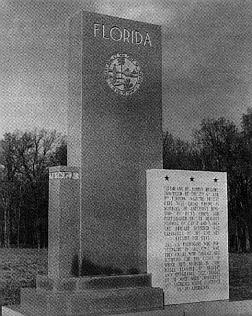
LOCATION: WEST CONFEDERATE AVENUE
DEDICATED: JULY 3, 1963
COST: $20,000
DESIGNER: J.B. HILL
CONTRACTOR: BRUNS MEMORIAL COMPANY
MATERIAL: SELECT SOUTHERN GRANITE
SPECIFICATIONS:
BASE-11' 8" L X 4'6" W
HEIGHT - 14'3"
PLINTH - 4'8" H X 1'6" W
PLINTH - 4' H X 1'5" W
 his one consists of a bronze statue of two figures. The first, a nine- foot long, reclining artilleryman represents a member of the Washington Artillery of New Orleans. Fallen, perhaps mortally wounded, a comrade covered his chest with a Confederate battle flag which the dying man has clutched to his heart. The second figure, a ten - foot tall female represents the "Spirit of the Confederacy ."1 A dove of peace is nestled in the reeds beneath the woman.
In her right hand held aloft is the flaming cannonball symbolic of ordnance and artillery. This perhaps lends greater credence to a variant explanation of the soaring figure. It has often been said that it represents St. Barbara, the patron saint of artillery - men. She was a woman who lived in Asia Minor about 3000 A.D., the daughter of a very wealthy man. Her conversion to Christianity infuriated her father who promptly took her before the province's prefect for judgment. There she was condemned to death by beheading, her own father carrying out the sentence. As he returned home after the execution, the legend states that he was struck by a lightning bolt which consumed her body. Because of this fate befalling her executioner, Barbara came to be regarded as the patron to be called upon to protect one in a storm. Gunpowder's invention, and the frequent accidental explosions that resulted from its use, led to St. Barbara gaining the additional role as the artlleryman's patron. 2
his one consists of a bronze statue of two figures. The first, a nine- foot long, reclining artilleryman represents a member of the Washington Artillery of New Orleans. Fallen, perhaps mortally wounded, a comrade covered his chest with a Confederate battle flag which the dying man has clutched to his heart. The second figure, a ten - foot tall female represents the "Spirit of the Confederacy ."1 A dove of peace is nestled in the reeds beneath the woman.
In her right hand held aloft is the flaming cannonball symbolic of ordnance and artillery. This perhaps lends greater credence to a variant explanation of the soaring figure. It has often been said that it represents St. Barbara, the patron saint of artillery - men. She was a woman who lived in Asia Minor about 3000 A.D., the daughter of a very wealthy man. Her conversion to Christianity infuriated her father who promptly took her before the province's prefect for judgment. There she was condemned to death by beheading, her own father carrying out the sentence. As he returned home after the execution, the legend states that he was struck by a lightning bolt which consumed her body. Because of this fate befalling her executioner, Barbara came to be regarded as the patron to be called upon to protect one in a storm. Gunpowder's invention, and the frequent accidental explosions that resulted from its use, led to St. Barbara gaining the additional role as the artlleryman's patron. 2
LOCATION: WEST CONFEDERATE AVENUE
DEDICATED: June 11, 1971
COST: $100,000
SCULPTOR: DONALD DELUE
CONTRACTOR: CAST IN ITALY
MATERIAL: POLISHED GREEN GRANITE
BRONZE
SPECIFICATIONS:
BASE - 9'10" SQ X 3'H
OVERALL HEIGHT - 22'
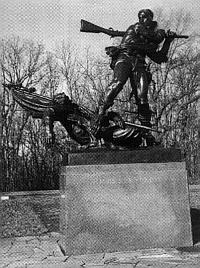 Built to honor eleven infantry regiments, one infantry battalion, one cavalry regiment, and one artillery battery from Mississippi, the monument illustrates the bravery, devotion, and sacrifice of the Mississippi soldier in the face of great odds.
Built to honor eleven infantry regiments, one infantry battalion, one cavalry regiment, and one artillery battery from Mississippi, the monument illustrates the bravery, devotion, and sacrifice of the Mississippi soldier in the face of great odds.The statue represents two infantrymen of Barksdale's brigade in their advance across the Shefry and Trostle farms. In the fierce fighting which will eventually overwhelm the Union Line along the Emmitsburg Road, one has fallen mortally wounded. His comrade has stopped beside him and using his musket as a club, defends the fallen flag. In the close hand to hand fighting that often characterized the battle on July, 2, this scene may have been witnessed many times. 1
1. Craven, Sculptures at Gettysburg, p. 90.
LOCATION: WEST CONFEDERATE AVENUE
DEDICATED: OCTOBER 19, 1973
COST: $100,000
SCULPTOR: DONALD DELUE
CONTRACTOR: CAST IN ITALY
MATERIAL: LAC DUBONNET GRANITE - BRONZE
SPECIFICATIONS:
BASE-7' 11" L X 3' 11"W
HEIGHT - 16' 2"

LOCATION: WEST CONFEDERATE AVENUE
DEDICATED: SEPTEMBER 21, 1961
DESIGNER: HARRY SELLERS
CONTRACTOR: MARIETTA MEMORIALS
MATERIAL: GEORGIA BLUE GRANITE
SPECIFICATIONS:
BASE: 7' 7" SQ
SHAFT: 3' SQ X 15' 6"
 Symbolically there are several features that clearly tie it to South Carolina, the most prominent feature being the sate outline and seal carved into the main shaft. On each side of the monument is a stone with a carved palmetto tree which underscores the nick name, of "Palmetto State". The side dies detail the names ands assignments of each South Carolina unit in the Army of Northern Virginia.
Symbolically there are several features that clearly tie it to South Carolina, the most prominent feature being the sate outline and seal carved into the main shaft. On each side of the monument is a stone with a carved palmetto tree which underscores the nick name, of "Palmetto State". The side dies detail the names ands assignments of each South Carolina unit in the Army of Northern Virginia.
At the bottom of the base is an excerpt from a song "Ode at Magnolia Cemetery" sung during ceremonies decorating graves of the Confederate dead on Confederate Memorial Day in April, 1867. "There is no holier spot of ground than where the defeated valor lies, by mourning beauty crowned." This was written by Henry Timrod, a native of Charleston. Active during the Civil War, and up until his death in 1867, Timrod wrote on Southern themes. His poems were so well known throughout the South that he received the title, "poet Laureate" of the Confederacy." The line was quite appropriate to this field and therefore was included on the monument.
LOCATION: WEST CONFEDERATE AVENUE
DEDICATED: JULY 2, 1963
COST: $15,000
DESIGNER: J.B. HILL
CONTRACTOR: BRUNS MONUMENT COMPANY
MATERIAL: WINBORO BLUE GRANITE
SPECIFICATIONS:
BASE - 23' L X 3'9" W
CENTRAL PLINTH - 5' 5" L X 2' 6" W X 14' 2" H

1 Martin, Confederate Monuments, pp. 36.
LOCATION: WEST CONFEDERATE AVENUE
DEDICATED: JUNE 18, 1966
COST: $50,000
CONTRACTOR: COBB MEMORIAL COMPANY
MATERIAL: MT. AIRY GRANITE
SPECIFICATIONS:
BASE - 28' L X 8'W X 8'6"H
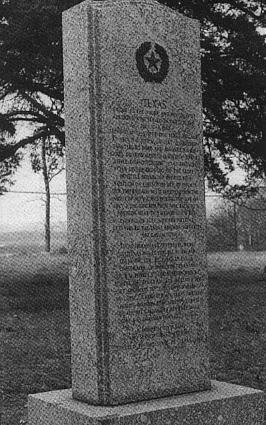 had been erected to honor the unit. The one here at Gettysburg, located only a short distance away, had been placed here in 1913, not through the efforts of private citizens.1
had been erected to honor the unit. The one here at Gettysburg, located only a short distance away, had been placed here in 1913, not through the efforts of private citizens.1The decision to place a state sponsored monument here was tied to an appropriation to erect identical monuments on eleven battlefields where Texas troops had fought .2 Those at Antietam and the Wilderness, along with the ones at Gettysburg, specifically honor the old Texas brigade. Constructed of Texas Red Granite, the monument's only adornment is the lone star of Texas placed near the top. This simple monument appears plain when compared with the other southern state monuments, but the fact that identical monuments exist on other fields serve to assure that the sacrifice of Texas soldiers on one battlefield was not made to appear any greater or less on any specific field.
1 Martin, Confederate Monuments, pp. 133
2 The eleven sites are: Antietam, Wilderness, Gettysburg, Bentonvile, Chicamauga, Fort Donelson, Kennesaw Mountain, Mansfield, Pea Ridge, Shiloh, Anthony, Texas. The only large scale monument specifically built to honor all Confederate soldiers was built at Vicksburg.
LOCATION: SOUTH CONFEDERATE AVENUE
DEDICATED: SEPTEMBER 1964
COST: $1,000
DESIGNER: HAROLD. B. SIMPSON
CONTRACTOR: STRASSWENDER MARBLE & GRANITE WORKS COMPANY
MATERIAL: TEXAS RED GRANITE
SPECIFICATIONS:
BASE - 3' 6" L X 2'6" H
SHAFT - 2'7"L X 1'W X 7'8"H
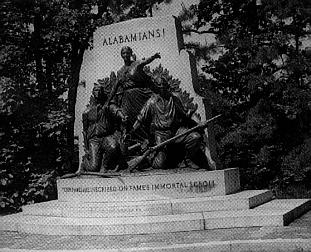 Alabama brigade, positioned on the extreme right of the Army of Northern Virginia, was centered about where the monument now stands.
Alabama brigade, positioned on the extreme right of the Army of Northern Virginia, was centered about where the monument now stands. The central figure of the sculpture represents the spirit of Alabama.1 The two sculptures on either side symbolize the "Spirit" and the "Determination" of all Alabama soldiers.2 On the left the wounded figure is being comforted by the female figure at the same time she urges the other soldier on. To indicate the continuance of the struggle, an ammunition pouch is being passed on to the soldier continuing the fight. The monument was dedicated in Novembers, 1933, seventy years after the battle.
1. See Craven, Sculptures at Gettysburg, p. 94; A variation of this is that the figure represents the "Spirit of the Confederacy"; Gilbert, The Blue and Gray, p. 55.
2. Gilbert, The Blue and Gray, p. 55.
LOCATION: SOUTH CONFEDERATE AVENUE
DEDICATED: NOVEMBER 12, 1933
COST: $12,000
SCULPTOR: JOSEPH W. URNER
DESIGNER/CONTRACTOR: HAMMAKER BROTHERS
BRONZE: ROMAN BRONZE COMPANY
MATERIAL: VERMONT GRANITE
STANDARD BRONZE
SPECIFICATIONS: OVERALL: - 19' L X 8'3"W X 12' H
TOTAL WEIGHT: 28 TONS
 Sculpted by Donald DeLue, the statue represents a charging southern color bearer, urging his comrades to follow him. The pink granite base contains the names of each of the states that contributed soldiers to the Confederate army. At the rear of the base is engraved the name of Walter Washington Wiliams who served as a forage master with a Texas regiment during the war. On December 19, 1959, at the age of one hundred and seventeen years, one month and five days, Williams died. The last member of the armed forces of the Confederate States of America had finally joined his comrades.1
1. There has been come controversy in the past over the validity of Walter Williams status as the "last" veteran. NPS officials currently doubt the claim, feeling that John B. Salling, a veteran of Company D of the 25th Virginia Infantry rightfully deserves the honor. Salling died March 16, 1959 at the age of one hundred and twelve years, ten months and one day.
Sculpted by Donald DeLue, the statue represents a charging southern color bearer, urging his comrades to follow him. The pink granite base contains the names of each of the states that contributed soldiers to the Confederate army. At the rear of the base is engraved the name of Walter Washington Wiliams who served as a forage master with a Texas regiment during the war. On December 19, 1959, at the age of one hundred and seventeen years, one month and five days, Williams died. The last member of the armed forces of the Confederate States of America had finally joined his comrades.1
1. There has been come controversy in the past over the validity of Walter Williams status as the "last" veteran. NPS officials currently doubt the claim, feeling that John B. Salling, a veteran of Company D of the 25th Virginia Infantry rightfully deserves the honor. Salling died March 16, 1959 at the age of one hundred and twelve years, ten months and one day.
LOCATION: SOUTH CONFEDERATE AVENUE
DEDICATED: AUGUST 25, 1965
SCULPTOR: DONALD DELUE
ARCHITECT: HENRY DACY
MATERIAL: PINK GRANITE
STANDARD BRONZE
SPECIFICATIONS: HEIGHT - 19'3"
CIRCUMFERENCE - 12'